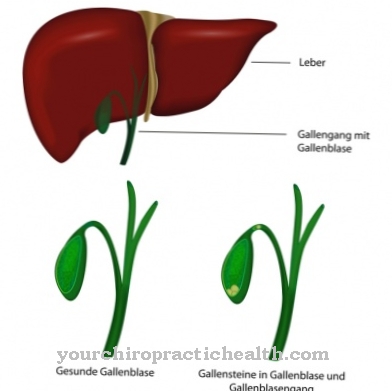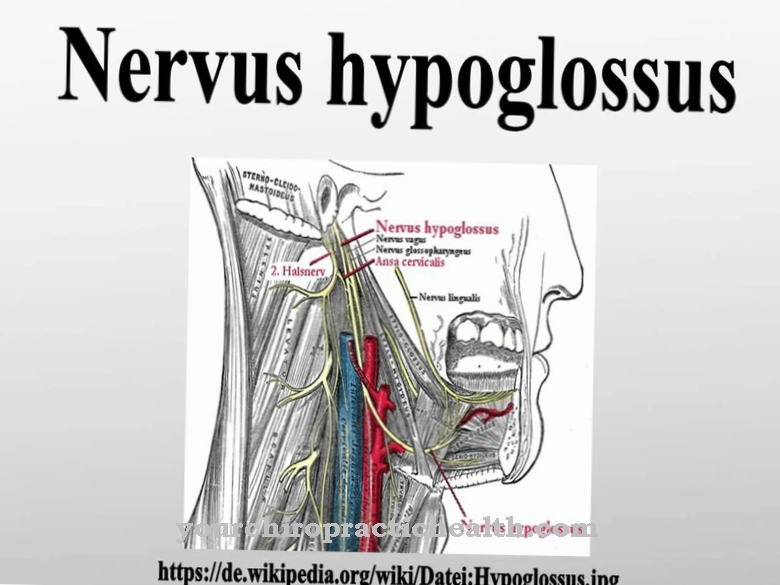When watching birds or z. B. Sharks can see a well-coordinated and fast movement in their activity, which however is rather rough and instinctive.
The motor function of such animals is controlled by the extrapyramidal system in the brain, while in humans and other mammals a more highly developed motor system is added to this motor system. It sits in the cerebral motor cortex and enables people to perform extremely fine, precise and very determined movements, e.g. B. to perform with his fingers or hand, this is it pyramidal system.
What is the pyramidal system?
The system of controlling all movements in humans and mammals is called the pyramidal system. This refers to the pyramidal tract of all converging nerve cell processes and the collection of central motor neurons, which in turn are efferent nerve cells and form the basis of the skeletal muscles.
The structure of these cells of origin is striking and arranged like a pyramid due to the course of the fibers and fiber connections. The pyramidal system does not function independently of the extrapyramidal system, as was assumed for a while, but rather controls the entire voluntary and involuntary motor function together with it.
Anatomy & structure
The pyramidal system is located directly in the cerebral cortex. Motor neurons there form cell bodies, which are called pyramidal cells and belong to the motor cortex. There are both small pyramidal cells and conspicuously large cells called Betz giant cells. This, in turn, is a neuronal cell type that is only present in the primary motor cortex.
Such giant cells are located in the fifth layer of the cerebral cortex and transmit their information through axons to the cranial nerve nuclei and the spinal cord. The number of such Betz cells is low. In humans there are about thirty thousand in the cerebral cortex.
Small pyramidal cells, on the other hand, are found everywhere in the cerebral cortex and especially in the isocortex, which differs from the second area of the allocortex. The third layer is populated with around seventy percent of nerve cells. This is where the majority of all information transfers and all processing takes place.
The pyramidal system is always related to the pyramidal tract, which forms the main part of this region and is a transition from the brain to the spinal cord. It always descends and transmits all impulses as a nerve path in these regions. It begins with the cell bodies of the motor cortex, also known as the precentral gyrus, which is a turn of the brain in front of the central groove, whereby the nerve fibers branching out from it bundle in the area of the inner capsule (internal capsule) and run over the cerebrum and bridge to the medulla oblongata.
This is where the particularly well-developed pyramid crossing of almost 90 percent of all fibers occurs in humans. The non-crossed fibers, in turn, continue to run and only cross in the spinal cord segment or end at the alpha motor neurons in the anterior horn cells in the spinal cord.
Function & tasks
The pyramidal trajectory is responsible for all arbitrary unconscious movements of the body muscles. It also inhibits basic muscle tension or the muscle reflex. This comes from the receptors of the muscle spindles, which control the length of the muscle fibers. The stimulus is identical in place and organ and is transmitted via a reflex arc.
The pathways in the extrapyramidal system, in turn, activate the limb and trunk muscles. This enables mass movements, which form the basis of all movements that run through the pyramidal path. The movement of the hand is again used as an example. In order to move this, the upper arm must also be moved. The latter happens through the extrapyramidal system.
You can find your medication here
➔ Medicines against memory disorders and forgetfulnessDiseases
If the pyramidal system is damaged, paralysis occurs. Defects are differentiated according to whether they occurred in the first or second neuron.
Such paralysis does not have to be complete, it can only affect certain regions, e.g. B. after a stroke, if there has been circulatory disturbance within the brain. If processes in the pyramidal system fail due to such a disruption, the extrapyramidal system takes over the control of some of the functions.
If the pyramidal tract within the brain is damaged, flaccid paralysis occurs. This leads to an impairment of the fine motor skills, to an uncontrolled movement of other muscles or to an awkwardness in the process of the motor skills. Most of the time, not only are the pathways in the pyramidal system blocked with such manifestations, but others are also affected. The flaccid paralysis then turns into a spastic one. Neurological symptoms under such circumstances are usually various reflexes, including, for example, the Babinski reflex in the foot.
In general, such neurological symptoms are called pyramidal signs, insofar as they are caused by a lesion of the pyramidal path. From a pathological point of view, very specific reflexes arise in the upper and lower extremities, which have become known under different names.
If, on the other hand, the extrapyramidal system is disturbed, the result is much more serious illness. An “extrapyramidal” motor function is always used when motor function processes are either not controlled via the pyramidal tract or take place outside of it. If disorders occur here, movement disorders can occur that are genetic or neurological. These include Huntington's disease and Parkinson's disease. Such diseases are caused by lesions in the primitive subcortical nuclei, disrupt muscle tone and result in abnormal or involuntary movements.
Parkinson's in particular is a slowly progressing, degenerative disease that usually occurs in old age and leads to hypokinetic movement disorders, which in turn are based on overactivity of all outgoing nuclei. Increased inhibitions are caused in the transfer to the corresponding projection pathways in the thalamus. Under such conditions, not only does the facial expression get lost and freeze into a mask, but arms and legs also begin to twitch uncontrollably.
Typical & common brain diseases
- dementia
- Creutzfeldt-Jakob disease
- Memory lapses
- Cerebral hemorrhage
- Meningitis












.jpg)



.jpg)










.jpg)
